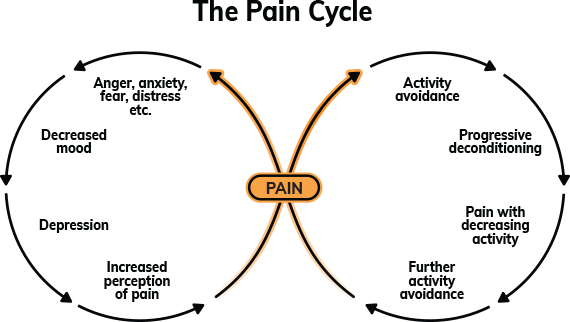What Is Pain?
Please note, pain can occur as a result of a number of different medical conditions or situations. While the information on managing and explaining pain may be of use, we always recommend you talk to your doctor or pharmacist before making any changes or decisions.
We’ve all experienced pain at some point in our lives, from an injury, an accident or as a result of a health condition, but there’s often a lot more to it than we think.
Are you taking prescription opioids or know someone who is? Explore the following resources to find out more.
Pain is a common experience, but it’s unique to each of us – no one person’s pain is ever experienced the same. This is because it’s a result of complex interactions connecting your body, mind and environment in that moment. It’s a powerful process designed to protect you and keep you physically safe. But sometimes it can be overprotective.
For a quick rundown on what pain is and how it works, check out the video below:
The Three Main Categories of Pain:
Pain is often grouped into three areas; acute pain, sub-acute pain and chronic pain. So what do these mean?
Acute pain is your body’s response to some form of tissue damage or swelling, usually as a result of an injury or illness. It can last a few moments, days or weeks, and tends to fade away as you begin to feel better. Rest and simple pain relief (such as heat packs, over-the-counter medicine or physical therapy) can help to reduce the pain and assist your recovery.¹
Sub-acute pain is the stage between acute and chronic pain. The acute pain you experienced immediately after your injury or illness will decrease in time as your recover, but some pain may continue. This is sub-acute pain. Lasting at least 6 weeks but less than 3 months, this is a key period of time when you can take control and reduce the risk of developing chronic pain.²
Chronic pain is present daily for more than three months. It can be due to an ongoing condition, disease or an injury where the pain continues beyond the time expected for body tissues to heal. Chronic pain can develop from a number of causes including nerve damage, scar tissue and aggravated underlying arthritis. It can also be referred to as Persistent Pain or Chronic Non-Cancer Pain (CNCP).³
Regardless of what category your pain falls into, we know pain is not a simple physical reaction, it’s a complex interaction between your body, mind and mood. Because of this complexity, you have the power to address how you experience pain in many different ways.
With multiple areas of your body working together to create pain, it makes sense that your pain can be impacted by different events and areas.
What Can Impact Your Pain Levels:
- Sleeping habits
- Activity/exercise
- Stress levels
- Diet
- Lifestyle choices
- Medication
- Thoughts, moods and emotions
To find out how you can best manage your pain and address the impacting factors, click here.
The Pain Cycle⁴
When pain is a regular part of your life, the effects can make it feel never ending and can negatively flow on to many areas of your life. The pain cycle below demonstrates the interactive relationship pain has with your physical and mental wellbeing. The good news, it shows several points where you can break the cycle and reduce its impact.

[1] Painaustralia, (2019), What Is Pain?
[2] Painaustralia, (2019), What Is Pain?
[3] Painaustralia, (2019), What Is Pain?
[4] Adapted from Cooper RG, Booker CK & Spanswick CC (2003), ‘What is Pain Management and what is its Relevance to the Rheumatologist’ in Rheumatology 24(10): 1133-1137